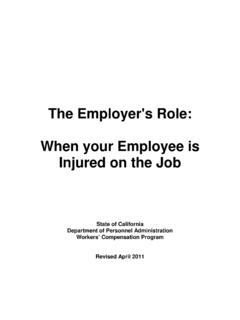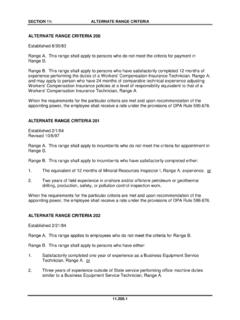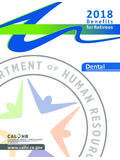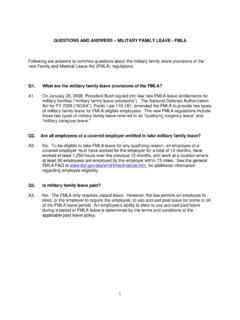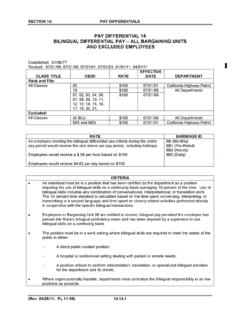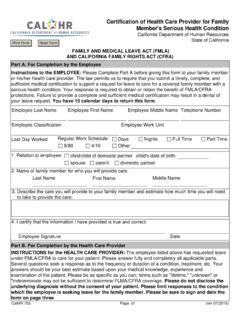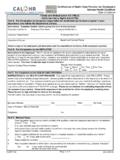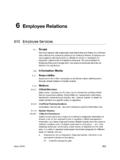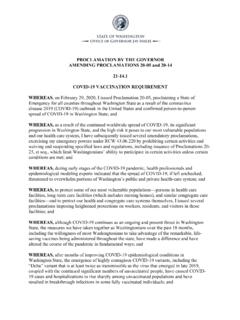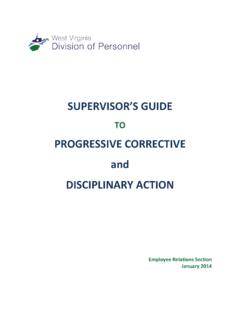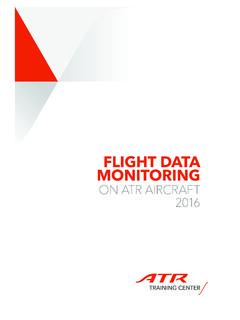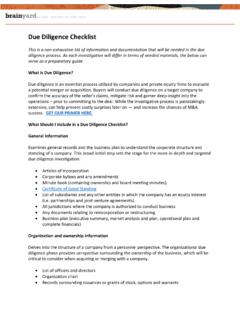Transcription of ORGANIZATIONAL PERFORMANCE MANAGEMENT & …
1 STATE OF CALIFORNIA ORGANIZATIONAL PERFORMANCE MANAGEMENT & MEASUREMENT Strategic Planning & PERFORMANCE Measurement Staff Training Handbook 2007 Edition Credits and Use CREDITS This handbook was developed under the direction of Dr. Denzil Verardo for the California PERFORMANCE Review. It was approved by the Office of Governor Schwarzenegger in July, 2004 for delivery to state agencies. The Handbook involved many state employees during its formative stages and later implementation stages. The handbook preparation team included: Rita Escobar, Ann Evens, Dr. David Illig, Sue Loustalot, Norma Ortega, Nicolas Schweizer, Jennifer Shaffer and Cindy Woolston. The original training preparation team included: Mary Fernandez , Mary Veliquette, Jennie Verardo, Tom Ward, and Pete Williams. Subsequent editions, under the purview of the State Personnel Board, were modified based on feedback and new materials by Jennie Verardo, Pete Williams and Dr.
2 Denzil Verardo. USE The material contained in this handbook may be freely copied with a credit line to the California PERFORMANCE Review. July, 2007 TABLE OF CONTENTS INTRODUCTION.. 1 PERFORMANCE MANAGEMENT Cycle .. 2 About this Handbook .. 4 I. A GUIDE TO STRATEGIC PLANNING.. 5 What is Strategic Planning ..5 The Purpose of Planning .. 5 The Strategic Planning Process .. 7 Do We Need to Change Direction? ..19 II. PERFORMANCE MEASUREMENT AND MANAGEMENT .. 20 PERFORMANCE Measurement -- How Do We Measure Progress? .. 20 Why Measure? .. 24 Developing and Using PERFORMANCE Measures .. 26 Key Steps for Using PERFORMANCE Measures.. 32 The relationship of support and administrative programs to Agency Mission and Core Programs.
3 34 Final Links .. 36 APPENDIX Appendix A: Glossary Appendix B: Worksheets CALIFORNIA STATE PERFORMANCE MANAGEMENT HANDBOOK IIff yyoouu ddoonn tt kknnooww wwhheerree yyoouu rree ggooiinngg,, hhooww aarree yyoouu ggoonnnnaa kknnooww wwhheenn yyoouu ggeett tthheerree?? Yogi Berra INTRODUCTION PERFORMANCE MANAGEMENT is the unified use of strategic planning, PERFORMANCE measurement, budgeting for results, and PERFORMANCE review. PERFORMANCE budgeting is the use of PERFORMANCE MANAGEMENT to tie program funding to demonstrated outcomes. The approach suggested in this handbook instructs agencies to: Identify the needs and demands of their customer/clients and the programs that meet those needs; Establish clear, measurable outcomes for those programs; and Produce and maintain a formal system of accountability and use information in budget development.
4 This fully-integrated process helps California state government become more creative, flexible, focused, and accountable in responding to customer/client needs. PERFORMANCE MANAGEMENT allows programs to direct scarce resources toward high priority and well-performing programs and services. Ultimately, the collection of techniques outlines in this handbook will, when fully integrated or implemented, enhance the PERFORMANCE of the public sector by improving the ability of California government to produce results. Implementing a PERFORMANCE MANAGEMENT system requires the simultaneous implementation and use of several components. At higher levels, PERFORMANCE MANAGEMENT links strategic planning and PERFORMANCE concepts with budget development. At the program level, PERFORMANCE MANAGEMENT links strategic plans to annual action plans, budget requests, and annual PERFORMANCE reviews all driven by outcome-based PERFORMANCE measures.
5 The PERFORMANCE MANAGEMENT Cycle shown on the next page illustrates the linkages between: The development of a strategic plan; The identification of PERFORMANCE measurements; The connection of budgeting resources for program implementation and desired results; The review of PERFORMANCE ; and The revision of the plan if necessary. The goal is accountability and quantifiable results that maximize the resources of California In practice, the cycle is not sequential. Illustration demonstrates interrelationship between key components The PERFORMANCE MANAGEMENT Cycle ABOUT THIS HANDBOOK This handbook was originally developed by the California PERFORMANCE Review and then minimally modified for use with the PERFORMANCE MANAGEMENT training sponsored by the California State Personnel Board. The intent of the handbook and the training remains helping agencies better engage in the PERFORMANCE MANAGEMENT process.
6 It is designed to assist agencies as they integrate planning, PERFORMANCE , and budgeting practices with overall agency MANAGEMENT . The California State PERFORMANCE MANAGEMENT Handbook is divided into four parts: I. A Guide to Strategic Planning II. PERFORMANCE Measurement and MANAGEMENT III. Annual PERFORMANCE Reports IV. Appendices (Glossary and forms) I. A GUIDE TO STRATEGIC PLANNING What is Strategic Planning? Strategic planning is planning for results. Strategic planning is a long-term, future -oriented process of assessment, goal setting, and strategy building that maps an explicit path between the present and a vision of the future . Strategic planning relies on careful consideration of an organization s capabilities and environment, and leads to priority-based resource allocation and other decisions. It is a disciplined and creative effort to produce fundamental decisions and actions that shape and guide what an agency is, what it does, and why it does it.
7 A strategic plan is an agency s comprehensive plan to address its business needs to successfully carry out its mission. Because strategic planning is a team effort that builds consensus on an agency s future direction, the process itself can be as important as the resulting plan. The Purpose of Planning The purpose of planning is to provide an organization with a comprehensive and orderly structure for identifying its goals; and developing strategies and securing the resources needed to reach its desired outcomes. Planning enables an organization to: Prepare for contingencies that could prevent it from attaining its goals; Develop a framework for its orderly growth and progress; Form the base for annual resource needs and the allocation of resources in a manner that will allow it to meet its goals and objectives; Provide for accountability based on results how services make a difference to customer/clients; and Link its results to funding in a way that identifies what taxpayers get for their tax dollars.
8 SWOT Mission & Vision Check Goals Strategies Objectives Mission & Vision Strategic Planning Analysis Environmental Scan The Strategic Planning Process 1. Select the Strategic Planning Team The Strategic Planning Team serves as the oversight and coordinating body of the planning process. In selecting the members of the team, address the following questions: Do the planning team members represent diverse areas and interests? Do they possess a variety of strengths, knowledge and skills? Are the knowledgeable about the agency? Are they knowledgeable about the primary customers or clients? Are they influential and persuasive with their constituents? Do they have access to, and an interest in, the long-term direction of the agency? Do they have the time and energy to commit to the strategic planning process? Can and will each member make a significant contribution to the planning effort?
9 2. Develop the Strategic Plan Framework The Strategic Planning Team needs to address the following issues to guide the overall process: What is the scope of the Strategic Plan? What is the length of time in the Plan period? How many years? What is our purpose in completing this planning process? Who should be involved in the Plan development and how? Who should review the Plan? What is the timeframe for completing the Plan? Who will manage the overall planning effort? What are the action steps needed to complete the Plan? Who is responsible for completing the action steps? When to the action steps need to be completed? 3. Identify Governor s Priorities and Legislative Mandates In addition to legislative mandates, agencies operate within an Administration where the Governor has priorities. An understanding of these priorities and the agency s role in supporting the Governor s agenda is essential for the Administration to operate successfully and ensure that limited resources are used judiciously.
10 To fully consider the legislative mandates, statutes and budget language that direct the agency, the following should be completed: Identify citations. Identify the underlying purpose of mandates. Identify primary requirements. What programs are required? Consider the degree of flexibility in meeting mandates. Is there a shared responsibility in meeting mandates? Determine the current status of meeting of mandates. Based on the Governor s priorities, do legislative changes need to be proposed? 4. Conduct an Internal/External Assessment (SWOT Analysis) The Internal/External Assessment (SWOT Analysis) is an analysis and evaluation of key internal and external data and factors that influence the success of an agency in achieving its Mission and Goals. It should be the first step in any plan development. An assessment of an agency s position, PERFORMANCE , problems and potential in other words, its Strengths, Weaknesses, Opportunities, and Threats is critical for understanding the context within which the planning occurs.
